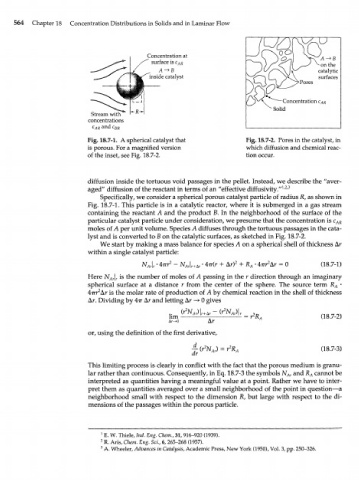Page 584 - Bird R.B. Transport phenomena
P. 584
564 Chapter 18 Concentration Distributions in Solids and in Laminar Flow
Concentration at
surface is c AR
inside catalyst
Stream with
concentrations
and
c AR c BR
Fig. 18.7-1. A spherical catalyst that Fig. 18.7-2. Pores in the catalyst, in
is porous. For a magnified version which diffusion and chemical reac-
of the inset, see Fig. 18.7-2. tion occur.
diffusion inside the tortuous void passages in the pellet. Instead, we describe the "aver-
aged" diffusion of the reactant in terms of an "effective diffusivity." ' 1 2 3
Specifically, we consider a spherical porous catalyst particle of radius R, as shown in
Fig. 18.7-1. This particle is in a catalytic reactor, where it is submerged in a gas stream
containing the reactant A and the product B. In the neighborhood of the surface of the
particular catalyst particle under consideration, we presume that the concentration is c
AR
moles of A per unit volume. Species A diffuses through the tortuous passages in the cata-
lyst and is converted to В on the catalytic surfaces, as sketched in Fig. 18.7-2.
We start by making a mass balance for species Л on a spherical shell of thickness Ar
within a single catalyst particle:
N \ • 4тгг 2 - N \ • 4тг(г + Ar) 2 + R • 4тгг Аг = О (18.7-1)
2
Ar r Ar r+Ar A
Here N \ is the number of moles of A passing in the r direction through an imaginary
Ar r
spherical surface at a distance r from the center of the sphere. The source term R •
A
2
4тгг Аг is the molar rate of production of A by chemical reaction in the shell of thickness
Ar. Dividing by 4тг Ar and letting Ar —> 0 gives
№r>Ur -№r>l, -
lim (18.7-2)
Ar
or, using the definition of the first derivative,
(18.7-3)
This limiting process is clearly in conflict with the fact that the porous medium is granu-
lar rather than continuous. Consequently, in Eq. 18.7-3 the symbols 1\Г and R A cannot be
Лг
interpreted as quantities having a meaningful value at a point. Rather we have to inter-
pret them as quantities averaged over a small neighborhood of the point in question—a
neighborhood small with respect to the dimension R, but large with respect to the di-
mensions of the passages within the porous particle.
1 E. W. Thiele, Ind. Eng. Chem., 31, 916-920 (1939).
2 R. Aris, Chem. Eng. Sci., 6, 265-268 (1957).
5 A. Wheeler, Advances in Catalysis, Academic Press, New York (1950), Vol. 3, pp. 250-326.

